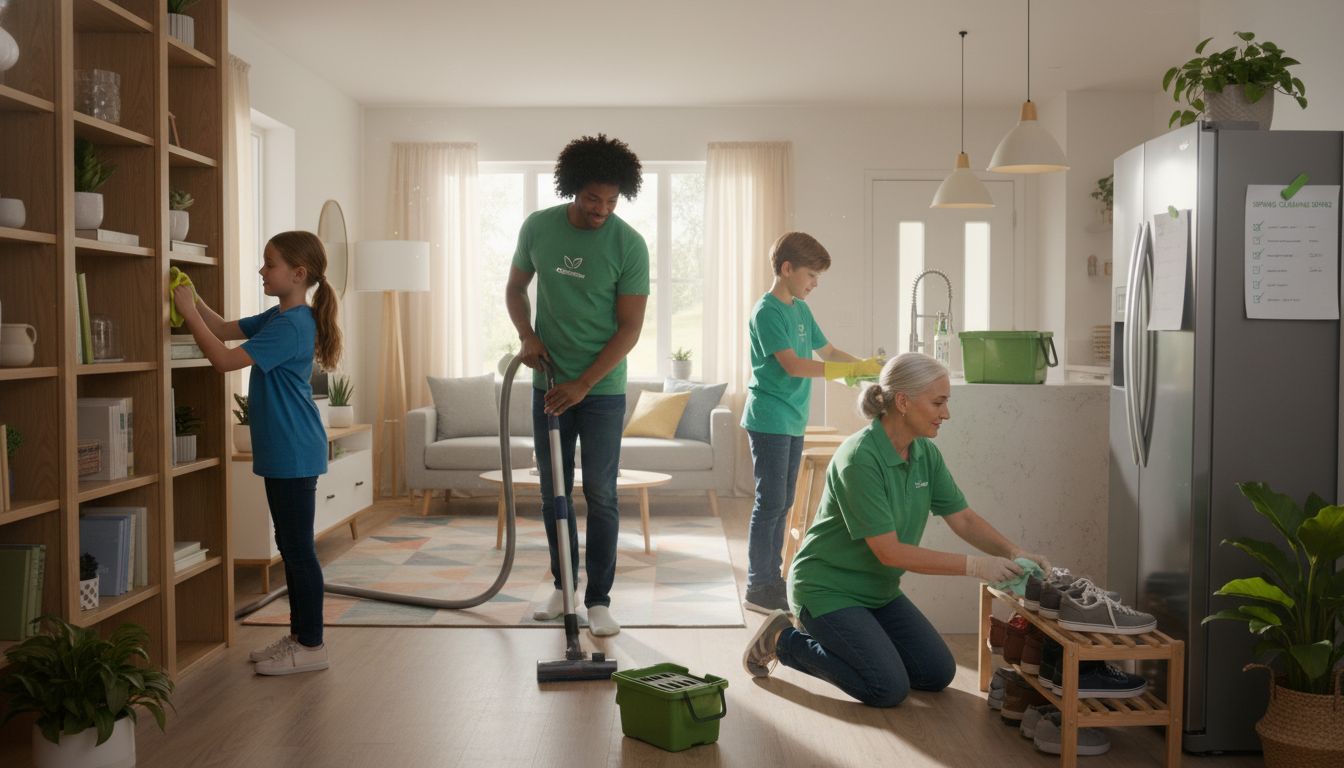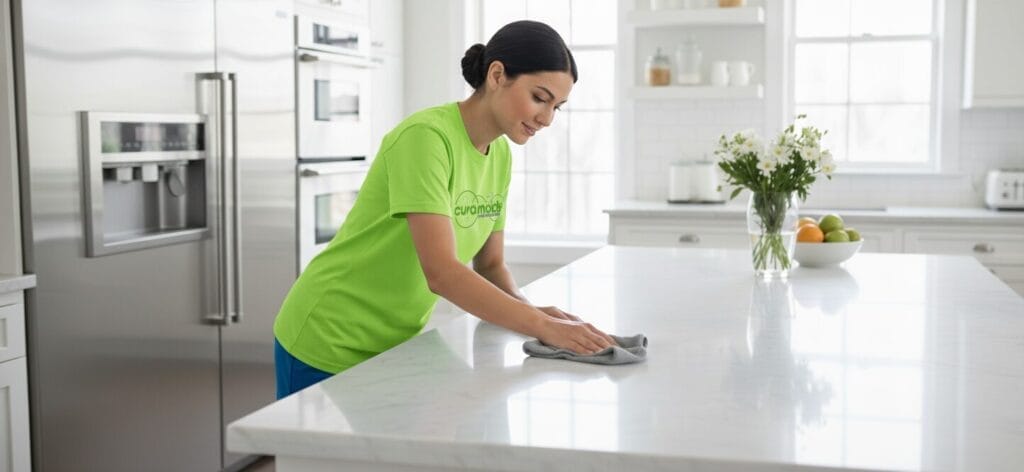7 Steps to an Effective Deep Cleaning Checklist for Busy Homes

Did you know the average home contains over 300,000 bacteria per square inch on household surfaces? Even the tidiest spaces can quickly collect dust, germs, and clutter. Keeping your home not just clean but deeply sanitized takes more than a quick sweep. By learning where germs hide and how simple steps can transform your cleaning routine, you can create a healthier, more comfortable home for everyone.
Table of Contents
- Declutter First To Maximize Cleaning Efficiency
- Dust And Wipe All Surfaces From Top To Bottom
- Deep Clean Kitchens: Appliances, Cabinets, And Sinks
- Sanitize Bathrooms: Showers, Toilets, And Fixtures
- Vacuum And Mop Floors, Carpets, And Rugs Thoroughly
- Refresh Bedrooms And Living Areas For Comfort
- Focus On High-Touch And Hidden Areas For A True Deep Clean
Quick Summary
| Takeaway | Explanation |
|---|---|
| 1. Declutter to Clean Efficiently | Clearing clutter first saves time and improves your cleaning efficiency. Spend a few minutes daily organizing. |
| 2. Dust from Top to Bottom | Always dust higher surfaces first to prevent dirt from settling on cleaned areas. This saves effort and time. |
| 3. Deep Clean Kitchen Appliances First | Start with large kitchen appliances to prevent cross-contamination and ensure systematic cleaning of smaller details. |
| 4. Sanitize High-Touch Surfaces | Focus on disinfecting frequently touched areas like doorknobs and light switches to reduce illness spread effectively. |
| 5. Refresh Living Spaces Regularly | Regular deep cleaning of living areas creates a healthier environment and enhances personal well-being for relaxation. |
1. Declutter First to Maximize Cleaning Efficiency
Before diving into deep cleaning, tackling clutter is your secret weapon for a more efficient and thorough home maintenance routine. Decluttering isn’t just about tidying up—it’s a strategic approach that transforms your cleaning process from overwhelming to manageable.
When surfaces are clear and items are in their designated places, cleaning becomes dramatically faster and more effective. According to cleaning experts, daily micro decluttering can prevent massive cleanup challenges later. This means spending just 5 10 minutes each evening putting items back where they belong.
Start with a systematic approach to decluttering:
- Clear off countertops and surfaces
- Put away clothing and accessories
- Return books magazines to shelves
- Sort through papers and mail
- Place toys games in their storage areas
As recommended by the guide on achieving a clutter free home, creating designated spaces for items reduces daily chaos. Think of decluttering as preparing your home’s canvas before the actual cleaning begins—you’ll save time energy and create a more peaceful living environment.
Pro tip: Keep a donation box in your closet. Whenever you encounter items you no longer need or use, immediately place them in the box. This prevents unnecessary accumulation and keeps your spaces streamlined and organized.
2. Dust and Wipe All Surfaces From Top to Bottom
Dusting might seem straightforward, but there is an art to making your surfaces truly clean. The key is working systematically from top to bottom to prevent re-contaminating areas you have already cleaned.
Gravity is your cleaning companion. When you dust high surfaces first like ceiling fans, light fixtures, and wall art, any falling dust will settle on lower surfaces. This means you can then clean those lower areas without repeating work. Think of it as a strategic top down approach that saves you time and energy.
Here are key surfaces to target during your deep cleaning:
- Ceiling fans and light fixtures
- Wall art and decorative items
- Air conditioning vents
- Window blinds and curtains
- Shelves and furniture tops
- Picture frames and electronics
Pro tip: Use microfiber cloths instead of traditional dusters. These cloths trap dust particles instead of just moving them around, making your cleaning more effective. When organizing your living room cleaning strategy, remember that consistent dusting prevents buildup and reduces allergens in your home.
Start at the highest point of each room and work your way down. This methodical approach ensures you capture dust before it settles on already cleaned surfaces, making your deep cleaning process more efficient and thorough.
3. Deep Clean Kitchens: Appliances, Cabinets, and Sinks
Your kitchen is the heart of your home and also the most challenging area to keep consistently clean. A thorough kitchen deep clean requires strategic attention to appliances, cabinets, and high traffic surfaces that accumulate grime and bacteria.
Start with your largest surfaces first. This means tackling major appliances like refrigerators, ovens, and stovetops before moving to smaller details. Cleaning from large to small prevents cross contamination and ensures a more systematic approach.
Key areas to focus on during your kitchen deep clean include:
- Oven interior and exterior
- Refrigerator shelves and drawers
- Stovetop and range hood
- Kitchen sink and faucets
- Cabinet fronts and handles
- Countertop surfaces and backsplash
Pro tip: Use specialized cleaning products designed for different surface materials. Stainless steel requires different care than ceramic or wooden surfaces. For additional insights into maintaining a spotless kitchen, check out our kitchen cleaning hacks that can save you time and effort.
Remember that consistent maintenance prevents major buildup. Spending 15 20 minutes after each cooking session wiping down surfaces can dramatically reduce the effort required during deep cleaning sessions. Your future self will thank you for developing these smart cleaning habits.
4. Sanitize Bathrooms: Showers, Toilets, and Fixtures
Bathrooms are high traffic zones that require meticulous attention during deep cleaning. More than just making surfaces look good, thorough bathroom sanitization protects your family from harmful bacteria and creates a healthier living environment.
Systematic cleaning is your best defense against bathroom grime and germs. Start from the top of your bathroom and work your way down, ensuring no surface is left untouched. This methodical approach prevents recontamination and ensures a comprehensive clean.
Key areas to focus on during bathroom deep cleaning include:
- Shower walls and glass doors
- Toilet bowl and exterior surfaces
- Sink and faucet fixtures
- Mirror and glass surfaces
- Countertops and cabinets
- Floor and baseboards
Pro tip: Use different cleaning cloths for different surfaces to prevent cross contamination. Microfiber cloths work wonderfully for mirrors and fixtures, while disposable or dedicated cleaning rags are best for toilet and floor areas. When you need expert guidance on maintaining a spotless home between deep cleans, our expert tips for home maintenance can provide additional insights.
Remember that thorough disinfection goes beyond visual cleanliness. Pay special attention to frequently touched surfaces like toilet handles, faucet knobs, and light switches. A few extra minutes of focused cleaning can significantly reduce the spread of germs in your household.
5. Vacuum and Mop Floors, Carpets, and Rugs Thoroughly
Floor cleaning is more than just making surfaces look clean—it is about creating a healthier living environment by removing dirt, allergens, and potential bacteria that accumulate daily. Different floor types require unique cleaning strategies to maintain their appearance and longevity.
Systematic floor cleaning prevents long term damage and preserves your home’s aesthetic appeal. Begin with vacuuming to remove loose debris before introducing moisture through mopping. This sequence prevents spreading dirt and ensures a more thorough clean.
Key strategies for comprehensive floor cleaning include:
- Use attachments for hard to reach edges
- Vacuum under area rugs and movable furniture
- Inspect carpets for stains and wear patterns
- Select appropriate cleaning solutions for each surface type
- Clean baseboards and floor edges
- Rotate and shake out area rugs periodically
Pro tip: Invest in microfiber mop heads and specialized cleaning solutions for different floor materials. Hardwood requires different care compared to tile or laminate surfaces. When the cleaning task feels overwhelming, remember that some house cleaning tasks might be best left to professionals who have specialized equipment and expertise.
Consistent floor maintenance not only improves your home’s appearance but also extends the life of your flooring. Spending a few extra minutes on thorough cleaning can save you significant money on replacement and repair costs in the long run.
6. Refresh Bedrooms and Living Areas for Comfort
Your living spaces are more than just rooms—they are sanctuaries where comfort and relaxation intersect. A thorough deep clean transforms these areas from mere functional spaces into rejuvenating environments that support your mental and physical well being.
Creating a clean living environment goes beyond surface level tidying. It involves a comprehensive approach that addresses every detail from ceiling to floor. Systematic cleaning helps eliminate allergens, reduces stress, and creates a sense of order that promotes relaxation and productivity.
Key areas to focus on during bedroom and living area refresh include:
- Organize clothing in dressers and closets
- Dust ceiling fans and light fixtures
- Clean window sills and A/C vents
- Vacuum under furniture and beds
- Polish wooden furniture and surfaces
- Arrange decorative items and artwork
Pro tip: Implement a donation system for clothing and items you no longer use. This not only helps you declutter but also supports community organizations. When the task feels overwhelming, remember that maintaining a clean home between professional services can make deep cleaning sessions much more manageable.
Think of this refresh as more than a cleaning task—it is an investment in your personal well being. A clean organized space reduces mental clutter and creates a peaceful environment where you can truly relax and recharge.
7. Focus on High-Touch and Hidden Areas for a True Deep Clean
Germs and bacteria love to hide in plain sight, and many homeowners unknowingly miss critical areas during cleaning. A true deep clean means targeting those sneaky spots where microbes thrive and multiply unseen.
Disease prevention starts with strategic cleaning. High touch surfaces are breeding grounds for bacteria and viruses, transferring pathogens quickly between family members. These areas require special attention and targeted disinfection techniques to maintain a healthy living environment.
Critical areas often overlooked during cleaning include:
- Doorknobs and handles
- Light switches and electrical plates
- Remote controls and electronic devices
- Cabinet and refrigerator handles
- Baseboards and air return vents
- Computer keyboards and mouse devices
Pro tip: Use disinfectant wipes or microfiber cloths specifically designated for high touch surfaces. When the task feels overwhelming, consider consulting our professional cleaning guide to understand comprehensive cleaning strategies.
Remember that consistent maintenance is key. Spending just a few extra minutes targeting these hidden zones can significantly reduce the spread of illness and create a healthier home environment for your entire family. Think of it as preventive healthcare through intelligent cleaning.
Below is a comprehensive table summarizing the main cleaning strategies and tips discussed throughout the article.
| Step | Key Points & Actions | Benefits/Outcomes |
|---|---|---|
| Declutter First | Clear surfaces, return items to rightful places, use donation box for unnecessary items. | More efficient cleaning, reduced chaos, and a peaceful environment. |
| Dust from Top to Bottom | Start with high surfaces, use microfiber cloths for effective dust trapping. | Saves time, reduces allergens, and prevents re-contamination. |
| Deep Clean Kitchens | Focus on major appliances first, clean systematically from large to small surfaces. | Prevents cross-contamination, systematic clean, and reduced grime. |
| Sanitize Bathrooms | Clean showers, toilets, and fixtures from top down, use separate cloths to avoid cross contamination. | Thorough disinfection, healthier environment, and reduced germs. |
| Vacuum and Mop Thoroughly | Vacuum before mopping, use attachments for edges and corners. | Preserves flooring, thorough dirt removal, healthier living environment. |
| Refresh Living Areas | Organize and dust, vacuum under furniture, and arrange decor. | Reduces mental clutter, promotes relaxation, and enhances well-being. |
| Focus on High-Touch Areas | Clean doorknobs, light switches, electronics with disinfectant wipes. | Reduces spread of illness, maintains hygienic environment. |
Simplify Your Deep Cleaning Routine with Professional Help
The challenge of following a thorough deep cleaning checklist can feel overwhelming for busy homes balancing work, family, and personal time. This article highlights key steps like decluttering, sanitizing high-touch areas, and detailed kitchen and bathroom care — all essential for creating a healthier, fresher living space. We understand how the time and effort needed to achieve this level of cleanliness can add stress rather than remove it.
That is where Cura Maids steps in to transform your cleaning experience. With flexible home cleaning services designed for busy lifestyles in Raleigh and the Research Triangle, we take deep cleaning off your to-do list while delivering consistent, sparkling results. Whether it is a one-time deep clean or recurring visits, our skilled and trusted team follows a proven 77-Star Cleaning Process focused on every detail described here.
Discover more insights in our Essential Deep Cleaning Tips for Sparkling Home | Cura Maids and explore practical advice across different areas in Cleaning Tips by Room Archives – Cura Maids Cleaning Tips by Room.

Ready to reclaim your weekends and enjoy a truly clean, healthy home without the hassle? Visit Cura Maids today to schedule your personalized deep cleaning service. Act now for a spotless home and more time for what matters most to you.
Frequently Asked Questions
What are the first steps for an effective deep cleaning checklist?
To begin an effective deep cleaning checklist, start with decluttering your space. Spend 5-10 minutes each day organizing items to create a manageable environment and make your actual cleaning process quicker.
How can I make dusting more efficient during deep cleaning?
For efficient dusting, always work from top to bottom, starting with high surfaces like ceiling fans and light fixtures. This method captures falling dust without re-contaminating areas you have already cleaned.
What should I focus on in the kitchen during a deep clean?
When deep cleaning your kitchen, prioritize areas such as the oven, refrigerator, and sink first before smaller details. Aim to spend around 20-30 minutes on these main surfaces to prevent grime buildup and cross contamination.
How often should I deep clean my bathrooms?
You should aim to deep clean your bathrooms at least once a month for optimal hygiene. Focus on high-touch areas and sanitize them thoroughly, allocating 30 minutes for a comprehensive clean each time.
How can I keep my floors clean in a busy home?
To maintain clean floors in a busy home, establish a routine of vacuuming and mopping at least once a week. This regular maintenance helps to remove dirt and allergens, promoting a healthier living environment.
What high-touch areas should I not forget in my deep cleaning routine?
Don’t overlook high-touch areas such as doorknobs, light switches, and remote controls during your deep clean. Spending a few extra minutes disinfecting these spots can significantly reduce the spread of germs in your home.


